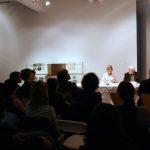Curated by Kenneth Silverman
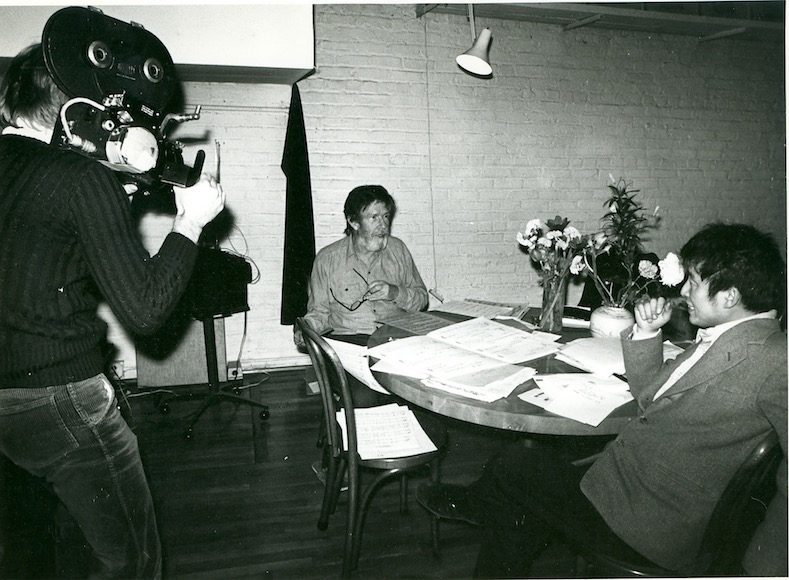
Photo: The John Cage Trust and the John Cage Collection, Northwestern University Music Library
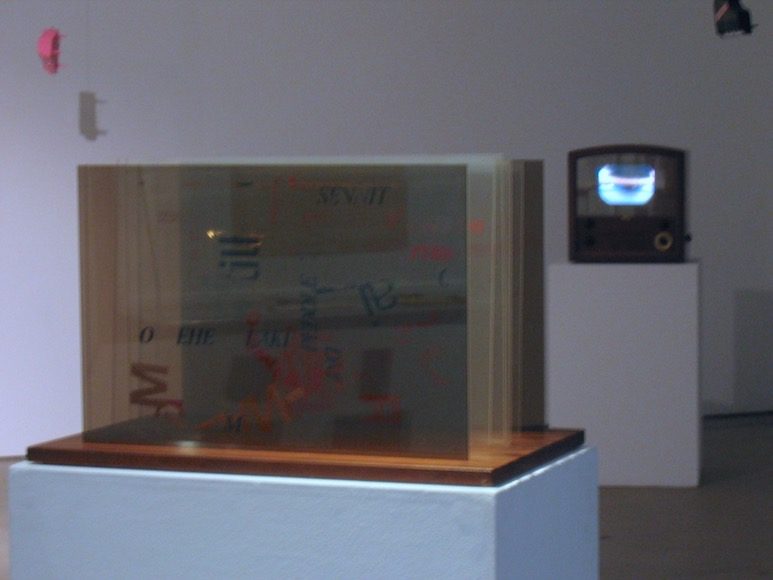
Installation view
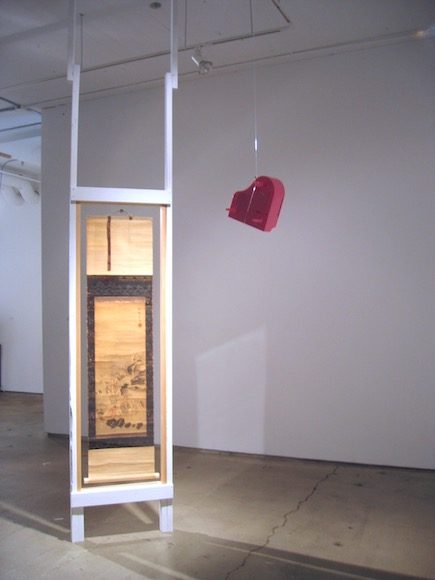
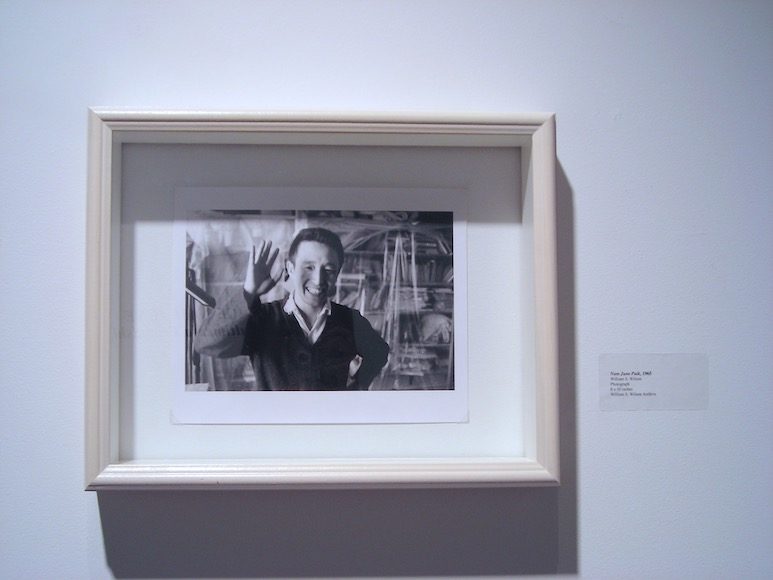
Nam June Paik, 1965
William S. Wilson Archive
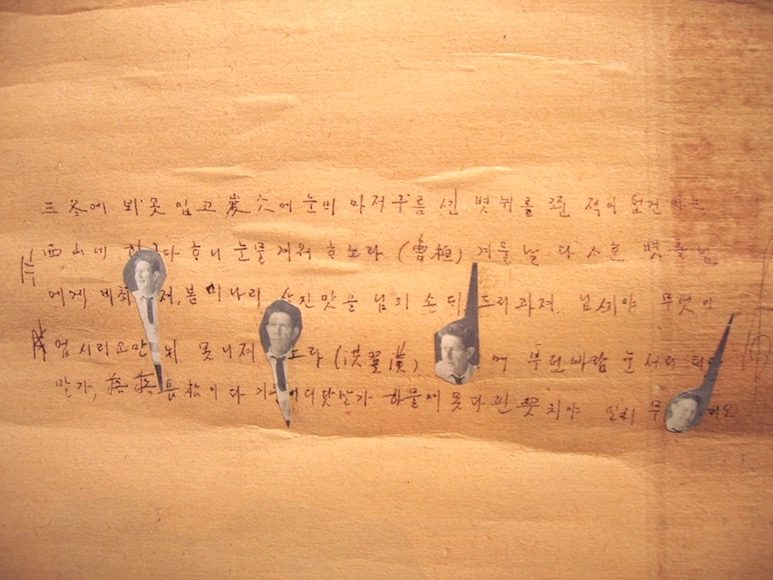
Nam June Paik
Mixed media on antique scroll
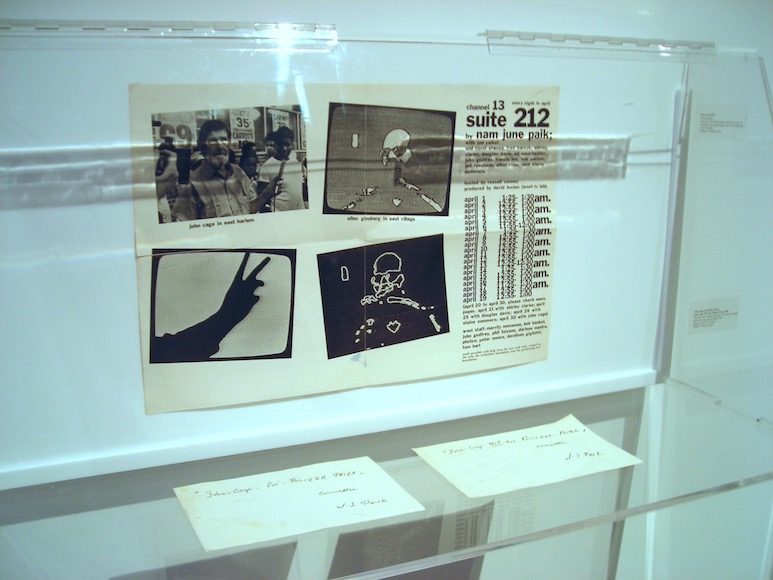
Suite 212, 1977
Poster for a set of film sketches about New York to be broadcast every night in April; April 30 with John Cage
John Cage for Pulitzer Prize, John Cage NOT for Pulitzer Prize, 1965
Nam June Paik’s double-sided flyer with contrary messages about John Cage and the Pulitzer Prize
William S. Wilson Archive
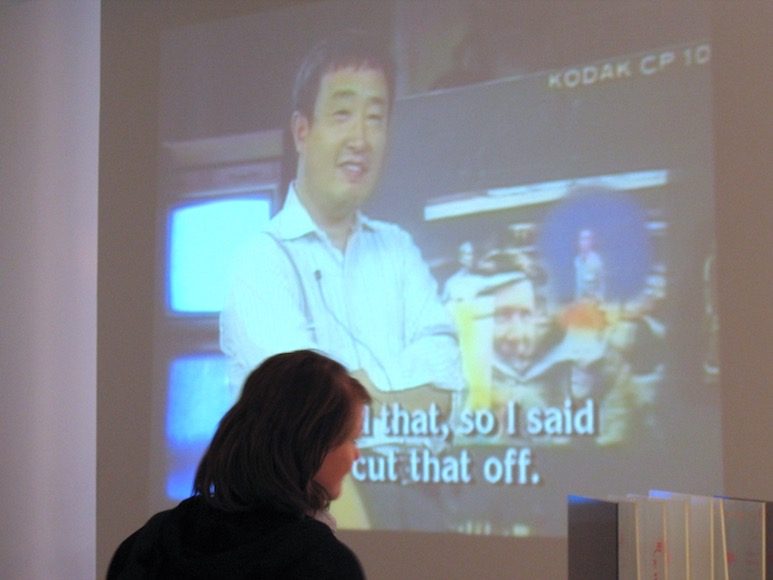
Directed by Elliot Caplan
Excerpt from Cage/Cunningham in which Nam June Paik talks about cutting off John Cage’s necktie
Courtesy of Cunningham Dance Foundation
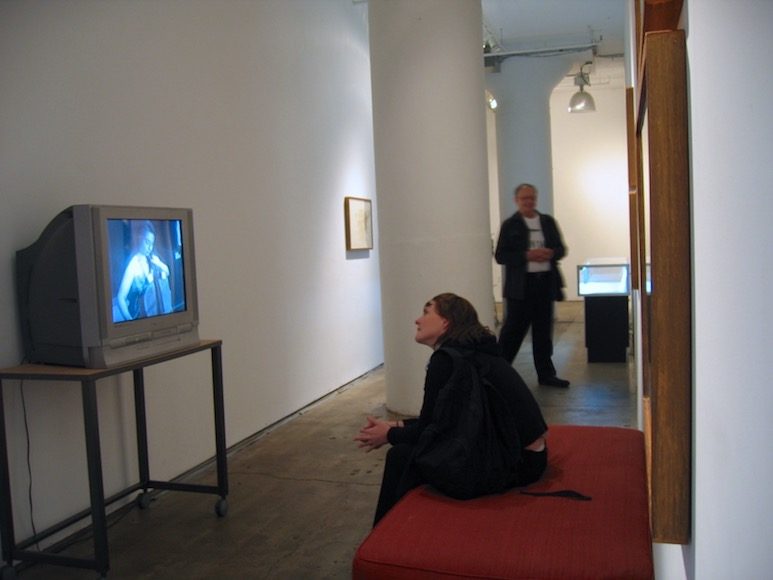
Filmed by Ira Schneider
Courtesy of Shigeko Kubota
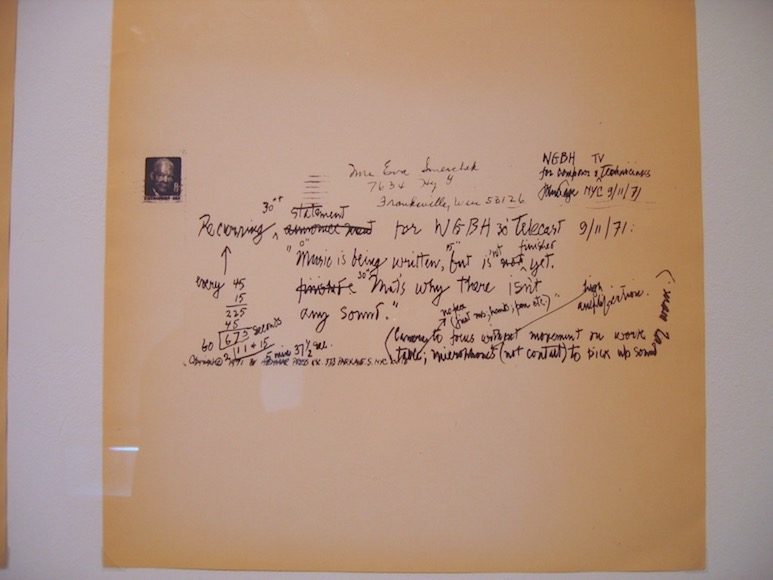
John Cage
Correspondence and notes regarding WGBH-TV, a composition for TV that John Cage dedicated to Nam June Paik
New York City and Cambridge, Mass, September 1971
Courtesy of C.F. Peters Corporation
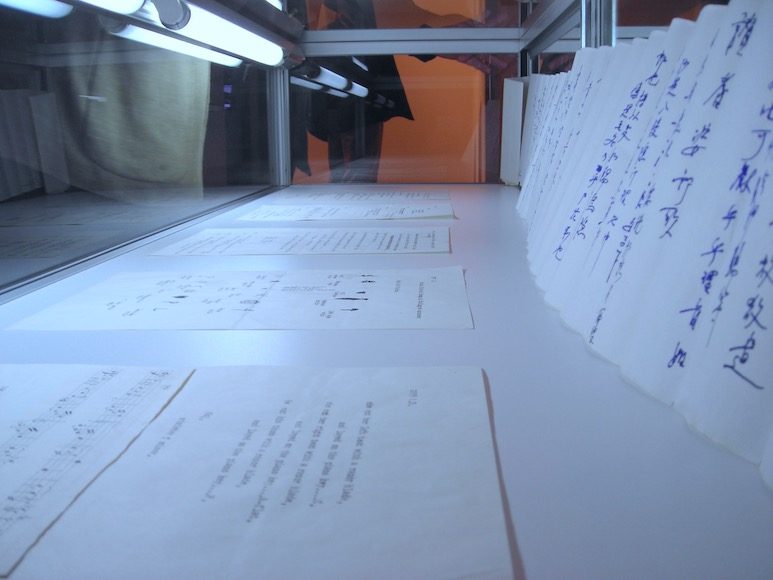
William S. Wilson Archive
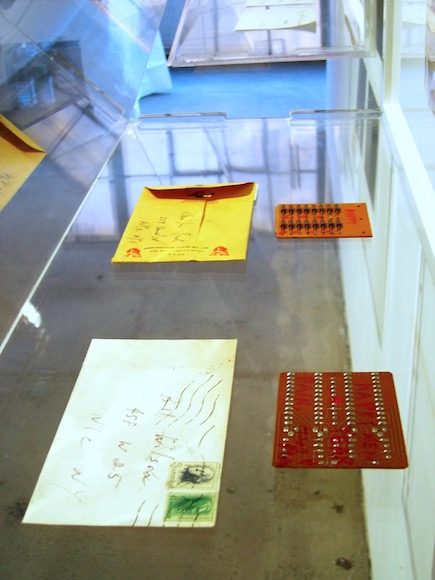
Nam June Paik’s New Years greeting card to William S. Wilson
Acrylic on circuit board
William S. Wilson Archive
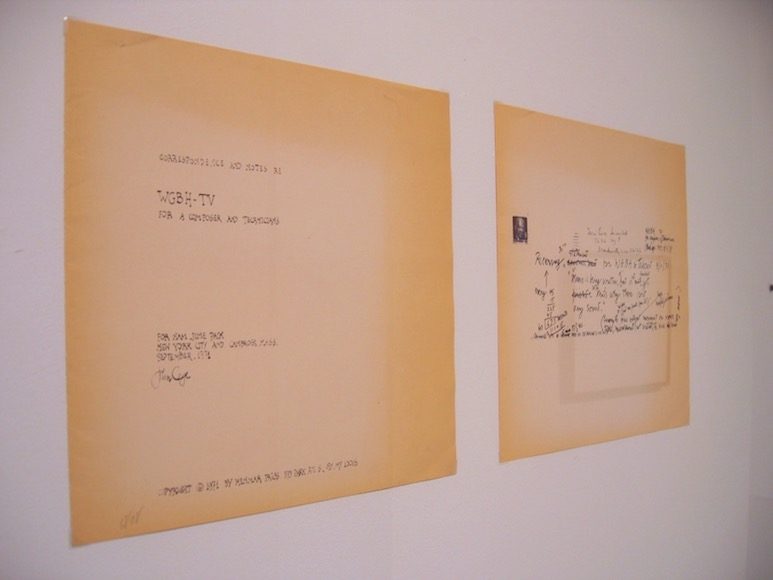
John Cage
Correspondence and notes regarding WGBH-TV, a composition for TV that John Cage dedicated to Nam June Paik
New York City and Cambridge, Mass, September 1971
Courtesy of C.F. Peters Corporation
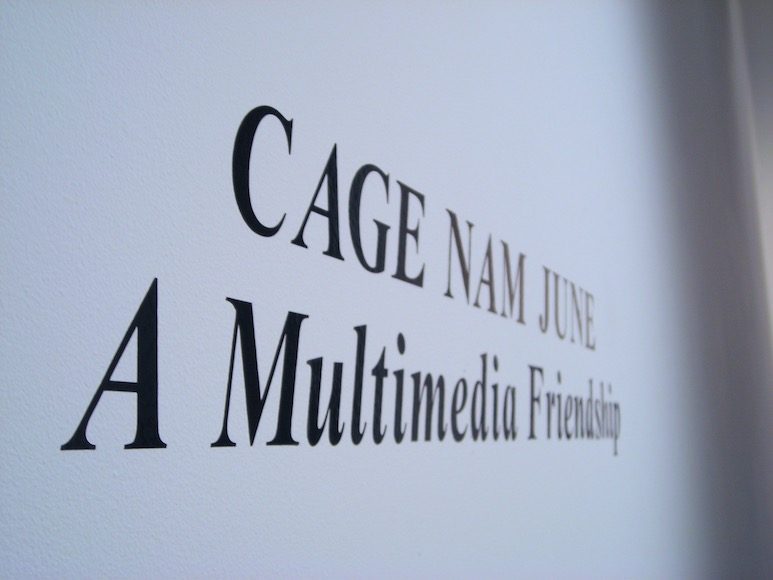
As part of its Homage to Nam June Paik series, ZONE: Chelsea Center for the Arts celebrates the nearly thirty-five year association between Nam June Paik and John Cage– two uniquely inventive and versatile creators.
In representing the association of these two joyously adventurous artists, ZONE: Chelsea Center for the Arts will exhibit representative scores, videos, music, drawings, photographs, writings, installations, video sculpture, objets sonores, and conceptual art. At the opening night performance on October 5, 7pm, the renowned Cage interpreter, Margaret Leng Tan, will celebrate the Cage-Paik legacy with her toy piano/toy instrumental Hommage à John Cage/Nam June Paik. In addition to the opening night’s event, the gallery will host a panel discussion on October 19, 7pm. The panel consists of the Fluxus artist Alison Knowles, the dancer and dance historian David Vaughan, the vocalist/composer Joan La Barbara and the writer and critic William S. Wilson, four people who knew and worked with Cage and Paik.
October 5 – November 3, 2006
Opening reception:
Thursday October 5th, 2006
6-8pm
with performance by Margaret Leng Tan
Panel discussion on October 19, 2006
7pm, with
Alison Knowles
David Vaughan
Joan La Barbara
William S. Wilson
Kenneth Silverman
ZONE: Chelsea Center for the Arts celebrates the nearly thirty-five year association between John Cage and Nam June Paik. Uniquely adventurous and versatile creators, they worked in music, video, radio, writing, sculpture, film, drama, dance, and graphic arts.
Their pasts make the association seem at first unlikely. Born in Los Angeles, the grandson and great-grandson of Methodist ministers, Cage was a college dropout, twenty years older than Paik. Born in Seoul, Korea, to wealthy owners of a textile company, Paik completed a graduate dissertation at the University of Tokyo.
The differences marked their earliest contacts. They met in 1958 at the annual International Holiday Courses for New Music in Darmstadt, Germany. As a composer, Cage was already well known for his use of chance operations based on an ancient Chinese text. Having heard that the American called upon Asiatic thought, Paik attended Cage’s concert, he later confessed, with a “very cynical mind.”
Cage had early misgivings about Paik, too. In 1960 he attended a performance in Cologne of Paik’s “Etude for Pianoforte.” After playing a few minutes of Chopin, Paik picked up long scissors and jumped off the stage to where Cage was sitting. Then, as Cage recalled the event, Paik “cut off my tie and began to shred my clothes, as if to rip them off of me.” After also pouring over Cage a bottle of shampoo, Paik barged through the crowd and out the door. The ‘Etude,’ Cage said, left him with a “grim memory” of Paik.
Yet they came to intensely enjoy and admire each other. As Paik continued listening to Cage’s music in Darmstadt, he recalled, “slowly, slowly I got turned on. At the end of the concert I was a completely different man.” In his 1991 Two Teachershe remarked that “Cage means ‘bird cage’ in English, but he didn’t lock me up; he liberated me.” The violence in some of Paik’s performance art—e.g. smashing a violin to bits–remained foreign to Cage, who abhorred violence. Still, when asked what he would miss most if he died tomorrow, he reportedly replied: “The conversation of Nam June Paik.”
They especially drew together after 1964, when Paik moved to New York City, settling into a loft in Soho. He loved the city, as did Cage. Much as Cage fed into a live electronic piece open telephone lines from Luchow’s Restaurant and Con Edison’s 14thstreet power station, Paik created a set of film sketches about New York, Suite 212 (1977), his title invoking the city’s area code. Cage introduced him around town, and they worked with many of the same people–Laurie Anderson, Joseph Beuys, Merce Cunningham. Paik also performed in concerts and events by Fluxus, the Dada-ish group born out of Cage’s experimental composition classes at the New School.
And when apart they often corresponded. Paik-like, Paik sometime sent banal postcards that he comically transformed by funny drawings and cartoons. Once he mailed Cage a greeting card made of bank receipts for bum checks he had written. “Your writing is superb,” Cage replied. “Send me the least little thing you write.”
Paik remains best known, of course, for seeing early on and then exploring the artistic possibilities of television. His 1963 show at a gallery in Wuppertal, Germany, was the first exhibition anywhere of Video art. Later he helped develop the video synthesizer; translating electronic impulses into abstract colors and shapes, it made the cathode ray tube a canvas. Among his many other video creations are human-shaped sculptures built out of TV monitors, including a video sculpture of Cage. The New York Timesart critic John Canaday called him the “John Cage of the ordinary domestic TV set.”
A performer by nature—like Paik—Cage appeared on such popular early television programs as The Henry Morgan Showand I’ve Got A Secret; the Italian TV version of Double or Nothing (as a contestant); and on one of the earliest cable TV programs. He eagerly lent himself to Paik’s many video films. In Paik’s Global Groovehe tells an anecdote; A Tribute to John Cageshows him seated outdoors in Harvard Square, not-playing 4’33”. For Paik’s ambitious Good Morning Mr. Orwell—a one-hour TV show transmitted by satellite between New York and Paris—Cage not only appeared but also made a lithograph to be sold by Paik in raising the million-dollar production cost.
Cage particularly admired Paik’s Zen for Film—sixty minutes of shapeshifting specks of dust. He preferred it, he said, “to any film I’ve ever seen before or after. It’s one of the great films.” Paik could be an equally ardent fan, He imagined establishing a Laser TV station to broadcast nothing but John Cage.
The current exhibition at ZONE: Chelsea offers some of the looks and sounds of this multimedia friendship—representative scores, music, videos, drawings, photographs, writings, installations, video sculpture, objets sonores, and conceptual art.
Kenneth Silverman
Kenneth Silverman is Professor Emeritus of English at New York University. His books include Timothy Dwight; A Cultural History of The American Revolution; The Life and Times of Cotton Mathe; Edgar A. Poe Mournful and Never-ending Remembrance; HOUDINI!!!.; and Lightning Man: The Accursed Life of Samuel F. B. Morse. A fellow of the American Academy of Arts and Sciences, he has received the Bancroft Prize in American History, the Pulitzer Prize for Biography, the Edgar Award of the Mystery Writers of America, and the Christopher Literary Award of the Society of American Magicians. Currently he is writing a biography of John Cage.
SPOTLIGHT
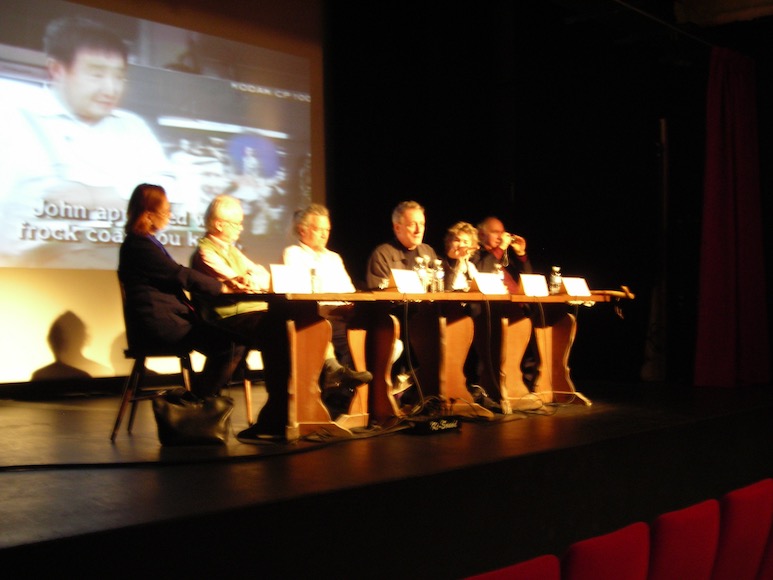
Panel Discussion in Paris, Moderated by George Quasha
Saturday, October 28th 2006, 6pm
Accompanying the exhibition, CAGE NAM JUNE: A Multimedia Friendship, ZONE: Chelsea Center for the Arts presents:
Panel Discussion in Paris during Digital Video Art Fair
Moderated by George Quasha
Saturday, October 28th, 2006
6pm at Theatre La Reine Blanche
2 bis passage Ruelle, 75019 Paris, France
Panelists:
Born in France, Jackie Matisse lived in New York until 1954. Since then she has lived in Paris making frequent visits to New York. Between 1959 and 1968 she worked for Marcel Duchamp, completing the assemblage of the “Boite en Valise”. At this time using her married name, Jacqueline Monnier, she began to make kites “in order to play with color and line in the sky”. In 1980 she showed kites which were created to be used underwater at the Betty Parsons Gallery in New York, and since then has continued to make kitelike objects intended for three different kinds of space: the sky, the sea, and indoor space, all linked through her use of movement.
Charles Stein is the author of Persephone Unveiled (a study of the Eleusinian Mysteries), eleven books of poetry including The Hat Rack Treeand the forthcoming From Mimir’s Headfrom Station Hill /Barrytown, Ltd., a long-term poetic project, theforestforthetrees, translations of Greek epic, philosophical, and Hermetic poetry; a critical study of the poet Charles Olson and his use of the writings of C.G. Jung called The Black Chrysanthemum(also from Station Hill Press). His work has been anthologized in such collections as Poems for the Millennium (U. of California Press), Hazy Moon Enlightenment(Shambala),Technicians of the Sacred(U. of California Press),Text-Sound Texts(Morrow), Open Poetry(Simon and Schuster) and has appeared in such magazines as American Poetry Review, Alcheringa, Caterpillar, Conjunctions, Ear Magazine, Perspectives of New Music, Temblor, Sulphur, Open Space,and many other poetry journals. He was the editor of an anthology Being=Space X Action: Searches for Freedom of Mind in Art, Mathematics and Mysticism.
He received an Individual Writer’s Grant from the National endowment for the Arts for 1978-79, and was the winner of the Wallace Stevens Poetry Prize in 1973.
He plays Gregory Bateson in video-installation artist Gary Hill’sWhy Do Things Get in a Muddle?and is one of the two performers (with George Quasha) in Gary Hill’s Tale Enclosure. He collaborated with Gary Hill and Paulina Wallenberg-Olsson in the creation of Dark Resonances—a performance/installation at the Colosseum in Rome. For three decades he has worked with George Quasha in the production of “dialogical” critical texts, including three books: Hand Heard/liminal objects: Gary Hill’s Projective Installations—Number 1, Tall Ships: Gary Hill’s Projective Installations—Number 2,and Viewer: Gary Hill’s Projective Installations—Number 3.His other collaborative writing with George Quasha related to Gary Hill’s work has appeared in art catalogues of the Stedelijk Museum of Amsterdam, the Kunsthalle of Vienna, the Barbara Gladstone Gallery of New York, Public Access of Toronto, the Voyager Laserdisc Gary Hill, etc.
In collaboration with Gary Hill and George Quasha, he has performed at the Long Beach Museum of Art, California, The Museum of Modern Art, Oxford, England, The Rhinebeck Performing Arts Center.
As a multi-media artist and “Sound Poet” his graphic “Text-Sound Texts” have been anthologized and performed by himself and others; his drawings have appeared as accompaniments to his own poetry. He has performed his sound poetry at the International Sound Poetry Festival, The New Moon Festival, The New Image Theater, as well as at numerous University sponsored, music, and literary venues.
His photography has appeared in exhibitions at The College Art Gallery of SUNY New Paltz, The University of Connecticut Library in Storrs, The Arnolfini Arts Center in Rhinebeck, New York, the Robert Louis Stevenson School in New York, New York, and on the covers of numerous books of poetry and fiction.
He holds a Ph.D. in literature and has taught at SUNY Albany, Bard College’s Music Program Zero, and The Naropa Institute.
He currently resides in Barrytown, New York.
Gary Hill is one of the most important contemporary artists investigating the relationships between words and electronic images — an inquiry that has dominated the video art of the past decade. Originally trained as a sculptor, Hill began working in video in 1973 and has produced a major body of single-channel videotapes and video installations that includes some of the most significant works in the field of video art. His first tapes explored formal properties of the emerging medium, particularly through integral conjunctions of electronic visual and audio elements.
His installations and tapes have been seen throughout the world, in group exhibitions at The Museum of Modern Art, New York; Centre Georges Pompidou, Paris; Documenta 8, Kassel, West Germany; Long Beach Museum of Art, California; Stedelijk Museum, Amsterdam, and the Video Sculpture Retrospective 1963-1989, Cologne, West Germany, among other festivals and institutions. Hill’s work has also been the subject of retrospectives and one-person shows at The American Center, Paris; Whitney Museum of American Art, New York; 2nd International Video Week, St. Gervais, Geneva; Musee d’Art Moderne, Villeneuve d’Ascq, France; and The Museum of Modern Art, New York.
Gary Hill created new large scale works for his solo exhibition at the Fondation Cartier pour l’art contemporain in Paris, October 27, 2006 – February 4, 2007.
.
Molly Davies started making experimental films in the late 1960s in New York City. For multi media performance pieces she has collaborated with artists including John Cage, David Tudor, Takehisa Kosugi, Lou Harrison, Michael Nyman, Alvin Curran, Fred Frith, Suzushi Hanayagi, Sage Cowles, Polly Motley, Jackie Matisse and Anne Carson. Her work has been presented at such sites as the Venice Film Festival, the Centre Pompidou, Musee de l’Art Moderne de la Ville de Paris, Musee Art Contemporain Lyon, The Getty, Theatre Am Turm, the Whitney Museum, the Walter Arts Center, the Kitchen, La Mama Etc., Dance Theatre Workshop, Jacob’s Pillow Dance Festival and the Indonesian Dance Festival. Her work is in the collections of the Getty Research Institute, the Musee Art Contemporain Lyon and the Walker Art Center. She teaches courses in design for inter-media performances at universities in the United States, Europe and Asia.
Artist and poet George Quasha works across mediums to explore principles in common within language, sculpture, drawing, video, sound, installation, and performance. His axial stones and axialdrawingshave been exhibited in New York’s Chelsea at Baumgartner Gallery and ZONE Chelsea Center for the Arts, and elsewhere, and are featured in the newly published book, Axial Stones: An Art of Precarious Balance(Foreword by Carter Ratcliff) (North Atlantic Books: Berkeley).
For his video installation art is: Speaking Portraits (in the performative indicative),he has filmed some 500 artists, poets, and composers (in 7 countries and 17 languages) saying “what art is.” His video works (including Pulp Friction, Axial Objects, Verbal Objects) have appeared internationally in museums, galleries, schools, and biennials. A 25 year performance collaboration (video/language/sound) continues with Gary Hill and Charles Stein.
In 2006 he was awarded a Guggenheim Fellowship in video art.
His other 14 books include poetry (Somapoetics, Giving the Lily Back Her Hands,Ainu Dreams [with Chie Hasegawa],Preverbs); anthologies (America a Prophecy [with Jerome Rothenberg], Open Poetry[with Ronald Gross],An Active Anthology[with Susan Quasha], TheStation Hill Blanchot Reader); and writing on art (Gary Hill: Language Willing;with Charles Stein: Tall Ships, HanD HearD/liminal objects,Viewer).
Awards include a National Endowment for the Arts Fellowship in poetry. He has taught at Stony Brook University (SUNY), Bard College, the New School, and Naropa University. With Susan Quasha he is founder/publisher of Barrytown/Station Hill Press in Barrytown, New York.
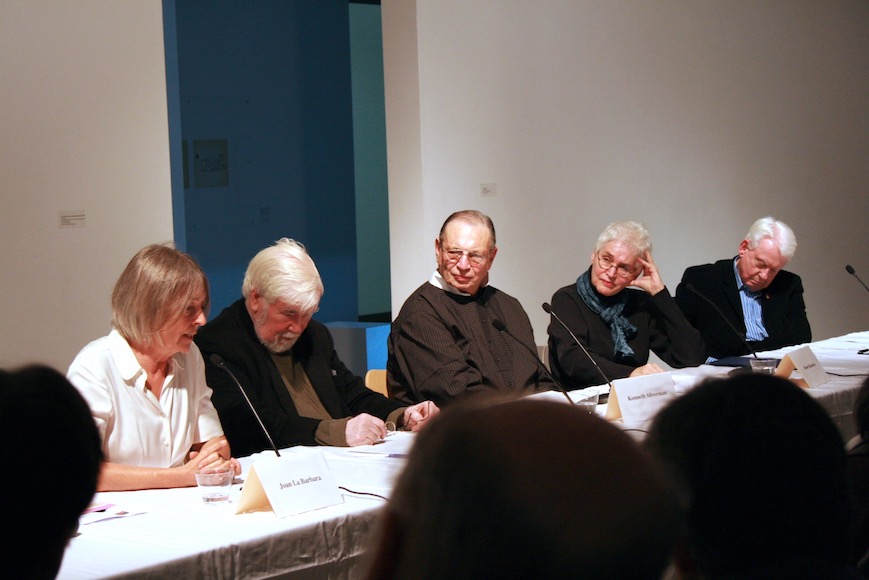
Panel Discussion, Moderated by Kenneth Silverman
Thursday, October 19th 2006, 7pm
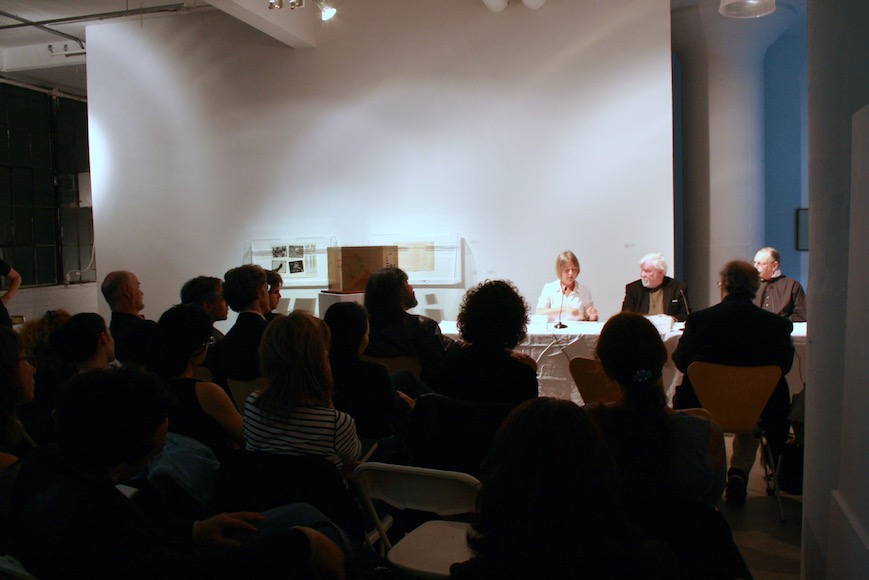
Panel Discussion, Moderated by Kenneth Silverman
Thursday, October 19th 2006, 7pm
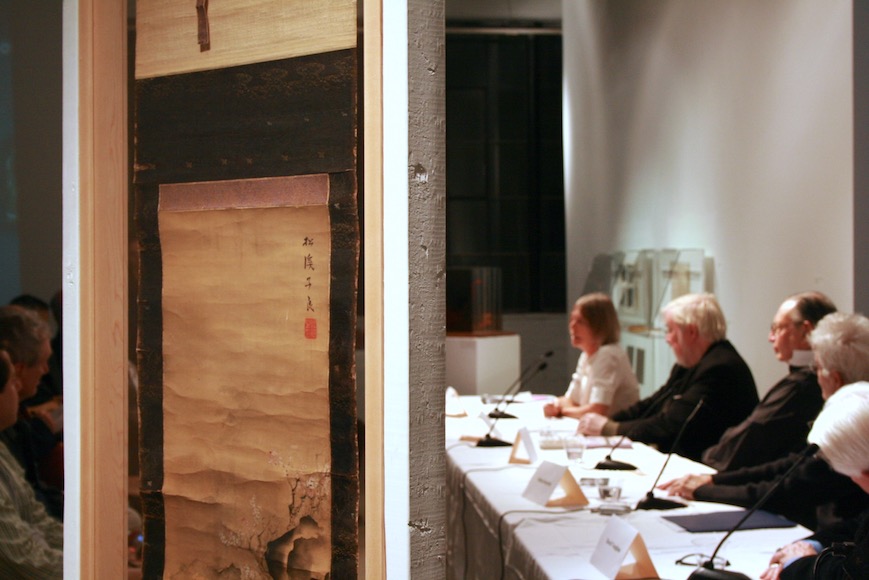
Panel Discussion, Moderated by Kenneth Silverman
Thursday, October 19th 2006, 7pm
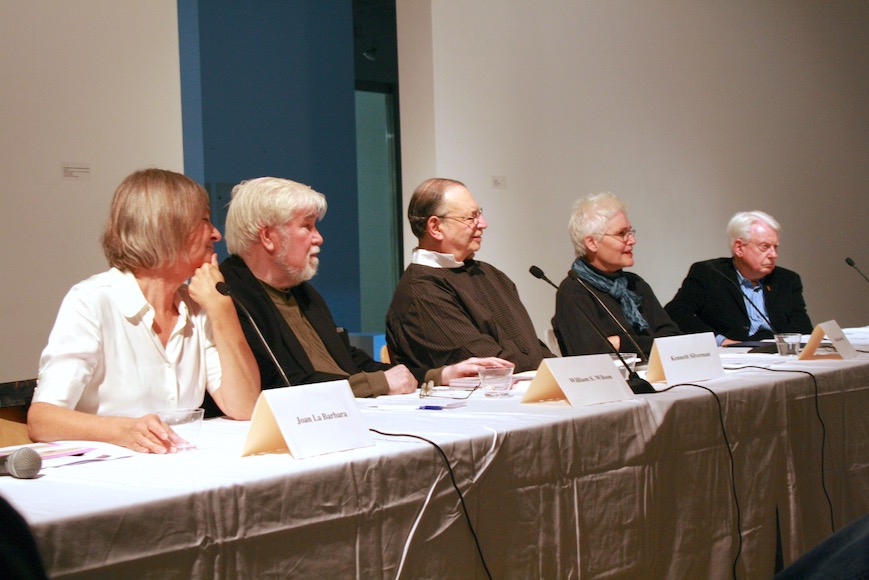
Panel Discussion, Moderated by Kenneth Silverman
Thursday, October 19th 2006, 7pm
Accompanying the exhibition, CAGE NAM JUNE: A Multimedia Friendship, ZONE: Chelsea Center for the Arts presents a Panel Discussion with four people who knew and worked with Cage and Paik.
Thursday, October 19th, 200 at 6:30 pm
Panelists:
the Fluxus artist Alison Knowles
vocalist/composer Joan La Barbara
dancer and dance historian David Vaughan
writer and critic William S. Wilson
curator Kenneth Silverman
ALISON KNOWLES was born in New York City. She works in the field of visual art, making performances, sound works and radio shows (Hoerspiele). She attended Scarsdale High School, Middlebury College and graduated with an honors degree in Fine Art from Pratt Institute in Brooklyn. She married the Fluxus artist Dick Higgins and worked for the Something Else Press doing special editions by silkscreen, engaged in events with the Fluxus group and birthed twin daughters Hannah B and Jessica in 1964. Her installation The Big Book was made in New York, and toured in Canada and Europe, collapsing in California in the mid-seventies. For three years she was Associate Professor of Art at California Institute of the Arts in the department of Alan Kaprow. Her computer instigated dwelling The House Of Dust is located in California as a permanent installation. During the late seventies and eighties she extended her studio to include a shop in Barrytown, New York, a stone’s throw from the Hudson River. During the eighties she has worked in Italy and Germany and Japan doing multiples, unique pieces and radio plays. Her second walk-in book The Book Of Bean from 1983 appeared in Venice. Her most recent exhibitions include “Um-Laut” in Koln and “Indigo Island” in Warsaw. She maintains a studio at 122 Spring St. in New York.
DAVID VAUGHAN was born in London and educated at Oxford University. He studied ballet with Marie Rambert and Audrey de Vos. In 1950 he continued his studies at the School of American Ballet, later studying with Antony Tudor, Richard Thomas, and Merce Cunningham. He has worked as a dancer, actor, singer, and choreographer, on film and television, in ballet and modern dance companies, and in cabaret. He is associate editor of Ballet Review and the Encyclopaedia of Dance and Ballet. He is the author of Frederick Ashton and His Ballets and the forthcoming Merce Cunningham: 50 Years, for which he received a Guggenheim Fellowship; and he has contributed to Dancers on a Plane: Cage, Cunningham, Johns and to Ornella Volta’s Satie et Ia danse. He has been associated with Merce Cunningham Dance Company since 1959, as archivist since 1976. He has taught dance history and criticism at New York University, the State University of New York/College at Purchase, the Laban Centre for Movement and Dance, the University of Chicago Dance History Seminar, and the American Dance Festival Critics’ Conference. In 1986 he was Regents’ Lecturer at the University of California.
JOAN LA BARBARA was born in Philadelphia, PA. Educated at Syracuse and New York Universities and Tanglewood/Berkshire Music Center, studying voice with Helen Boatwright, Phyllis Curtin and Marian Szekely-Freschl, she learned her compositional tools as an apprentice with the numerous composers with whom she has worked for three decades. Her career as a composer/performer/soundartist explores the human voice as a multi-faceted instrument expanding traditional boundaries, creating works for multiple voices, chamber ensembles, music theater, orchestra and interactive technology, developing a unique vocabulary of experimental and extended vocal techniques: multiphonics, circular singing, ululation and glottal clicks that have become her “signature sounds”, garnering awards in the U.S. and Europe. La Barbara has collaborated with artists including Lita Albuquerque, Cathey Billian, Melody Sumner Carnahan, Judy Chicago, Ed Emshwiller, Kenneth Goldsmith, Peter Gordon, Bruce Nauman, Steina, Woody Vasulka and Lawrence Weiner. In the early part of her career, she performed and recorded with Steve Reich, Philip Glass and jazz artists Jim Hall, Hubert Laws, Enrico Rava and arranger Don Sebesky, developing her own unique vocal/instrumental sound. In addition to the internationally-acclaimed “Three Voices for Joan La Barbara by Morton Feldman” “Joan La Barbara Singing through John Cage” and “Joan La Barbara/Sound Paintings”, she has recorded for A&M Horizon, Centaur, Deutsche Grammophon, Elektra-Nonesuch, Mode, Music & Arts, MusicMasters, Musical Heritage, Newport Classic, New World, Sony, Virgin, Voyager and Wergo. Recording projects as singer and/or producer include “Only: Works for Voice and Instruments” by Morton Feldman”; “Rothko Chapel/Why Patterns”, “John Cage at Summerstage with Joan La Barbara, Leonard Stein and William Winant”, Cage’s final concert performance on July 23, 1992 in NYC’s Central Park. La Barbara was Artistic Director of the Carnegie Hall series, “When Morty met John”, celebrating the music of John Cage and Morton Feldman and The New York School; is Artistic Director, Curator and Host of “Insights”, a new series of encounters with distinguished composers, for The American Music Center; and co-produces the “EMF 10” concert series in New York City. Joan La Barbara is a member of SAG, AFTRA, AEA, The American Music Center, and is a composer and publisher member of ASCAP.
WILLIAM S. WILSON, who was graduated with a Ph.D. from Yale University, has taught the writing of fiction at Queens College and the Graduate Writing Division of Columbia University. Author of a book of short stories, Why I don’t write like Franz Kafka, he has been writing essays about visual art since 1964. Nam June Paik lived in a studio in his house during1964-65. He has given talks about Eva Hesse in Paris, London, San Francisco and New York.
KENNETH SILVERMAN – Curator Kenneth Silverman is Professor Emeritus of English at New York University. His books include Timothy Dwight; A Cultural History of the American Revolution; The Life and Times of Cotton Mathe; Edgar A. Poe: Mournful and Never-ending Remembrance; HOUDINI!!!.; and Lightning Man: The Accursed Life of Samuel F. B. Morse. A fellow of the American Academy of Arts and Sciences, he has received the Bancroft Prize in American History, the Pulitzer Prize for Biography, the Edgar Award of the Mystery Writers of America, and the Christopher Literary Award of the Society of American Magicians. Currently he is writing a biography of John Cage.
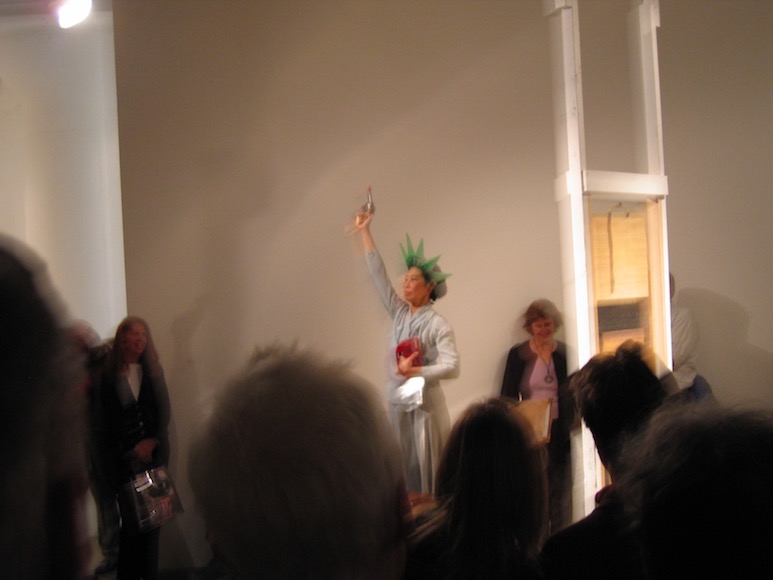
Hommage to John Cage and Nam June Paik by Margaret Leng Tan
Thursday, October 5th 2006, 7pm
Accompanying the exhibition, CAGE NAM JUNE: A Multimedia Friendship, at the opening night performance on October 5, 7pm, the renowned Cage interpreter, Margaret Leng Tan, celebrate the Cage-Paik legacy with her toy piano/toy instrumental Hommage to John Cage/Nam June Paik.
Thursday, October 5th, 2006 at 7 pm
Program
HOMMAGE to JOHN CAGE/NAM JUNE PAIK
by
MARGARET LENG TAN
toy piano, toy instruments
HOMMAGE to NAM JUNE PAIK (2006) – first performance
Margaret Leng Tan
SUITE FOR TOY PIANO (1948)
John Cage
4′ 33″ (1952
John Cage
from OLD McDONALD’S YELLOW SUBMARINE (2004) – BICYCLE LEE HOOKER toy piano, bicycle bell and horn, train whistle
Erik Griswold
CHOOKS – toy piano and wood blocks
Margaret Leng Tan
5’29.75″ FOR SIX TOY PLAYER PIANOS / Elegy for Nam June (2006) – first performance
Erik Griswold
STAR-SPANGLED ETUDE #3 (“Furling Banner”) (1996) – toy piano, siren, whistle, cap gun
Raphael Mostel
Margaret Leng Tan has established herself as a major force within the American avant-garde; a highly visible, talented and visionary pianist whose work sidesteps perceived artificial boundaries within the usual concert experience and creates a new level of communication with listeners. Embracing aspects of theater, choreography, performance and even “props” such as the teapot she “plays” in Alvin Lucier’s Nothing is Real,Tan has brought to the avant-garde, a measure of good old-fashioned showmanship tempered with a disciplinary rigor inherited from her mentor John Cage. This has won Tan acceptance far beyond the norm for performers of avant-garde music, as she is regularly featured at international festivals, records often for adventurous labels such as Mode and New Albion and has appeared on American public television, Lincoln Center and even at Carnegie Hall.
Born in Singapore, Tan was the first woman to earn a doctorate from Juilliard, but youthful restlessness and a desire to explore the crosscurrents between Asian music and that of the West led her to Cage. This sparked an active collaboration between Cage and Tan that lasted from 1981 to his death, during which Tan gained recognition as one of the pre-eminent interpreters of Cage’s piano music, partly through her New Albion recordings, Daughters of the Lonesome Isleand The Perilous Night/Four Walls. After Cage’s death in 1992, she was chosen as the featured performer in a tribute to his memory at the 45th Venice Biennale.
Tan takes a lively interest in the musical potential of unconventional and unlikely instruments, and in 1997 her groundbreaking CD, The Art of the Toy Piano on Point Music/Universal Classics elevated the lowly toy piano to the status of a “real” instrument. Tan is certainly the world’s first, and so far, only professional toy piano virtuoso. Since then her curiosity has extended to other toy instruments as well, substantiating her credo “Poor tools require better skills” (Marcel Duchamp).
Tan favors music that confronts and defies the established boundaries of the piano and her toy instruments and has collaborated with like-minded composers to create works for her, such as Somei Satoh, Tan Dun, Michael Nyman, Julia Wolfe, Toby Twining and Ge Gan-ru; she is also a favorite of composer George Crumb. Tan’s authority on matters of Cage has evolved from that of an expert interpreter to responsible scholar protecting the textual integrity of his work; Tan edited the fourth volume of Cage’s piano music for C. F. Peters and in 2006 gave the premiere of his newly discovered 1944 work Chess Pieces, which she also edited for publication. Tan’s Mode DVD of Cage’s Sonatas and Interludes includes a video in which she examines the original, 1940s era preparation materials for the work. Photogenic and comfortable with the camera, Tan is the subject of a feature documentary by filmmaker Evans Chan, Sorceress of the New Piano: The Artistry of Margaret Leng Tan,which receives its New York premiere at the Pioneer Two Boots Theater on September 23/24.
Related:
Categories: exhibitions
Tags: CAGE NAM JUNE
